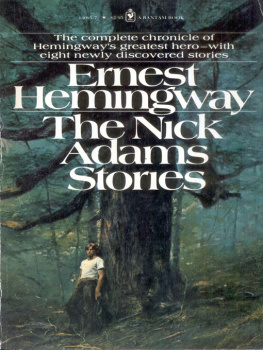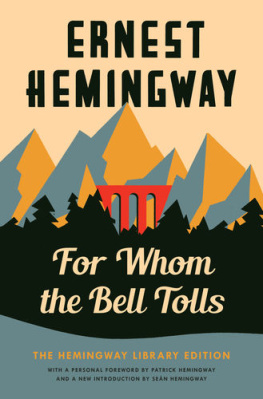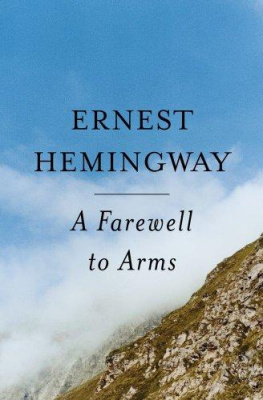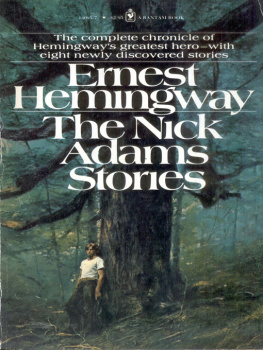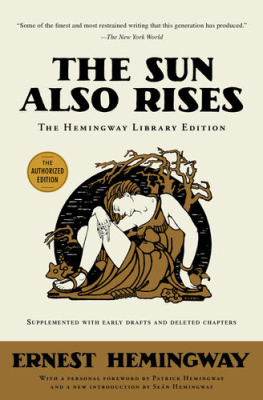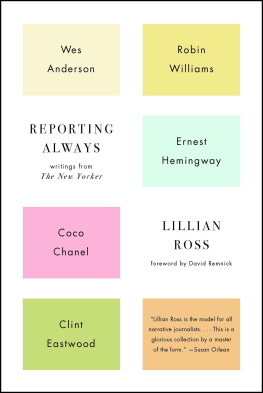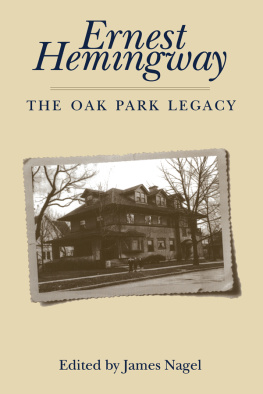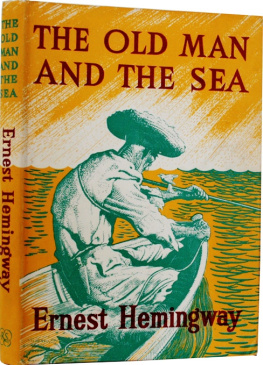Ernest Hemingway - The Nick Adams Stories
Here you can read online Ernest Hemingway - The Nick Adams Stories full text of the book (entire story) in english for free. Download pdf and epub, get meaning, cover and reviews about this ebook. year: 1980, publisher: Bantam Books, genre: Detective and thriller. Description of the work, (preface) as well as reviews are available. Best literature library LitArk.com created for fans of good reading and offers a wide selection of genres:
Romance novel
Science fiction
Adventure
Detective
Science
History
Home and family
Prose
Art
Politics
Computer
Non-fiction
Religion
Business
Children
Humor
Choose a favorite category and find really read worthwhile books. Enjoy immersion in the world of imagination, feel the emotions of the characters or learn something new for yourself, make an fascinating discovery.
- Book:The Nick Adams Stories
- Author:
- Publisher:Bantam Books
- Genre:
- Year:1980
- Rating:3 / 5
- Favourites:Add to favourites
- Your mark:
- 60
- 1
- 2
- 3
- 4
- 5
The Nick Adams Stories: summary, description and annotation
We offer to read an annotation, description, summary or preface (depends on what the author of the book "The Nick Adams Stories" wrote himself). If you haven't found the necessary information about the book — write in the comments, we will try to find it.
The Nick Adams Stories — read online for free the complete book (whole text) full work
Below is the text of the book, divided by pages. System saving the place of the last page read, allows you to conveniently read the book "The Nick Adams Stories" online for free, without having to search again every time where you left off. Put a bookmark, and you can go to the page where you finished reading at any time.
Font size:
Interval:
Bookmark:
The Hemingway Mystique
and the Hemingway Mystery
No figure of our time has been more admired, more criticized, more spectacular, yet more secretive of his inner depths than Ernest Hemingway. His life was a mixture of strange contradictions, his death a startling shock.
In the mirror of his art, however, Hemingway revealed himself as few men have ever done. His fictional creation, Nick Adams, sheds inimitable light on Hemingway, the man, even as he stands as a supreme expression of Hemingways genius as a writer. Now Hemingway comes alive on the printed page as he never has before in
THE NICK ADAMS STORIES
Stands with The Sun Also Rises and A Farewell to Arms as his finest work. Certainly no other book can provide a better introduction to Hemingways work, life and thought, beginning at the very beginning.
Minneapolis Tribune
Books by Ernest Hemingway
ACROSS THE RIVER AND INTO THE TREES
* BY-LINE: ERNEST HEMINGWAY
DEATH IN THE AFTERNOON
A FAREWELL TO ARMS
* THE FIFTH COLUMN AND FOUR UNPUBLISHED STORIES OF THE SPANISH CIVIL WAR
FOR WHOM THE BELL TOLLS
THE GREEN HILLS OF AFRICA
THE HEMINGWAY READER
IN OUR TIME
* ISLANDS IN THE STREAM
MEN AT WAR
MEN WITHOUT WOMEN
* A MOVEABLE FEAST
* THE NICK ADAMS STORIES
THE OLD MAN AND THE SEA
THE SHORT STORIES OF ERNEST HEMINGWAY
THE SNOWS OF KILIMANJARO AND OTHER STORIES
THE SUN ALSO RISES
TO HAVE AND HAVE NOT
THE TORRENTS OF SPRING
WINNER TAKE NOTHING
* Published by Bantam Books
THE
NICK ADAMS
STORIES
BY
ERNEST HEMINGWAY
PREFACE BY PHILIP YOUNG
This low-priced Bantam Book
has been completely reset in a type face
designed for easy reading, and was printed
from new plates. It contains the complete
text of the original hard-cover edition.
NOT ONE WORD HAS BEEN OMITTED.
RL 5, IL 7-up
THE NICK ADAMS STORIES
A Bantam Book / published by arrangement with Charles Scribners Sons
PRINTING HISTORY
Scribners edition published April 1972
Bantam edition / March 1973
2nd printing ... January 1974 5th printing ... February 1977
3rd printing ... February 1975 6th printing ... January 1978
4th printing ... April 1976 7th printing ... March 1979
8th printing ... February 1980
Publication of the eight previously unpublished pieces in this book is the result of a gift of the English language rights by Mary Hemingway to The Ernest Hemingway Foundation.
All rights reserved.
Copyright 7972 The Ernest Hemingway Foundation.
Preface by Philip Young Copyright 1972 Charles Scribners Sons,
Copyright 1969 Mary Hemingway.
Copyright 1933 Charles Scribners Sons, renewal copyright 1961 Mary Hemingway.
Copyright 1925 Charles Scribners Sons; renewal copyright 1953 Ernest Hemingway.
Copyright 1927 Charles Scribners Sons; renewal copyright 1955.
Copyright 1927 Charles Scribners Sons; renewal copyright 1955 Ernest Hemingway.
Copyright 1927 Macaulay Company; renewal copyright 1955 Ernest Hemingway.
This book may not be reproduced in whole or In part, by
mimeograph or any other means, without permission.
For information address: Charles Scribners Sons,
597 Fifth Avenue, New York, N.Y. 10017.
ISBN 0-553-14095-7
Published simultaneously In the united States and Canada
Bantam Books are published by Bantam Books, Inc. Its trademark, consisting of the words Bantam Books and the portrayal of a bantam, is Registered in U.S. Patent and Trademark Office and in other countries. Marca Registrada. Bantam Books, Inc., 666 Fifth Avenue, New York, New York 10019.
PRIN TE D IN THE UNITED STATES OF AMERICA
17 16 15 14 13 12 11 10 9 8
Of the place where he had been a boy he had written well enough. As well as he could then. So thought a dying writer in an early version of The Snows of Kilimanjaro. The writer of course was Hemingway. The place was the Michigan of his boyhood summers, where he remembered himself as Nick Adams. As well as he could write then was very well indeed.
Until now, however, the stories involving Nick have always appeared so many to a book, in jumbled sequence. As a result the coherence of his adventures has been obscured, and their impact fragmented. In Men Without Women, Hemingways second collection of stories, Nick appears first as a soldier in Italy, next as an adolescent in Summit, Illinois, then in turn as a younger boy in Michigan, a married man in Austria, and a soldier back in Italy. Or consider the trouble with Big Two-Hearted River, one of the best-known Hemingway stories. Placed where it wasat the end of In Our Time, the first collectionit puzzled a good many readers. Put where it goes chronologically, following the stories of World War I, its submerged tensionsthe impression that Nick is exorcising some nameless anxietybecome perfectly understandable. But A Way Youll Never Be, which precedes Big Two-Hearted River in time and explains it, was published eight years and several books after it.
Arranged in chronological sequence, the events of Nicks life make up a meaningful narrative in which a memorable character grows from childhood to adolescent to soldier, veteran, writer, and parenta sequence closely paralleling the events of Hemingways own life. In this arrangement Nick Adams, who for a long time was not widely recognized as a consistent character at all, emerges clearly as the first in a long line of Hemingways fictional selves. Later versions, from Jake Barnes and Frederic Henry to Richard Cantwell and Thomas Hudson, were all to have behind them part of Nicks history and, correspondingly, part of Hemingways.
As is true for many writers of fiction, the relationship between Hemingways work and the events of his own life is an immediate and intricate one. In some stories he appears to report details of actual experience as faithfully as he might have entered them in a diary. In others the play of his imagination has transformed experience into a new and different reality. Exploring the connections between actuality and fiction in Hemingway can be an absorbing activity, and readers who wish to pursue it are referred to the biographical studies listed at the end of this preface. But Hemingway naturally intended his stories to be understood and enjoyed without regard for such considerationsas they have been for a long time.
The first Nick Adams fiction appeared almost a half-century ago, the last in 1933, and over the years a great deal has been written about it. Among the unpublished manuscripts Hemingway left behind him, however, eight new contributions to the over-all narrative were discovered. Presented here for the first time, inserted in the places in time where the events fall, they are varied in length and apparent purpose. Three accountsof how the Indians left the country of Nicks boyhood, of his first sight of the Mississippi, and of what happened just before and after his weddingare quite brief. If the author had larger plans for any of them, such are unknown; they might be read simply as sketches in an artists notebook. In two other cases his plans are self-evident, for here we have the beginnings of works that were never completed. Nick on board the Chicago, bound for France during World War I, was the start of a novel called Along with Youth that was abandoned long ago. Similarly, though much later, the plot of The Last Good Country was left in mid-air, and many pages would have been required to resolve it. Two other pieces are known to have originated in Nick stories already published. Three Shots tells how the young boy became frightened while on a camping trip. It once preceded the story called Indian Camp. And Nicks stream of consciousness reflections on his writing career once (anachronistically) concluded Big Two-Hearted River. Of these new works only Summer People , very likely the first fiction Hemingway wrote about Nick Adams, can be regarded as a full-length, completed story.
Next pageFont size:
Interval:
Bookmark:
Similar books «The Nick Adams Stories»
Look at similar books to The Nick Adams Stories. We have selected literature similar in name and meaning in the hope of providing readers with more options to find new, interesting, not yet read works.
Discussion, reviews of the book The Nick Adams Stories and just readers' own opinions. Leave your comments, write what you think about the work, its meaning or the main characters. Specify what exactly you liked and what you didn't like, and why you think so.

